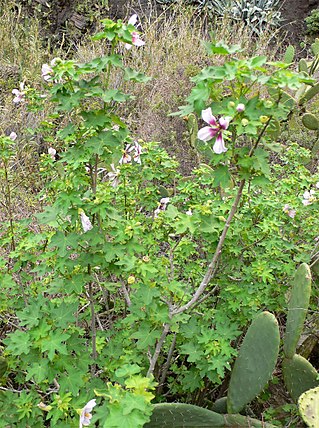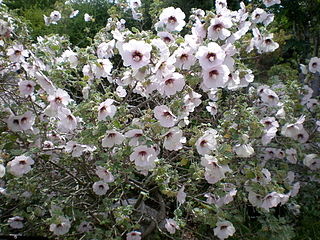
Geranium is a genus of 422 species of annual, biennial, and perennial plants that are commonly known as geraniums or cranesbills. They are found throughout the temperate regions of the world and the mountains of the tropics, but mostly in the eastern part of the Mediterranean region.

Fuchsia is a genus of flowering plants that consists mostly of shrubs or small trees. The first to be scientifically described, Fuchsia triphylla, was discovered on the Caribbean island of Hispaniola about 1696–1697 by the French Minim monk and botanist, Charles Plumier, during his third expedition to the Greater Antilles. He named the new genus after German botanist Leonhart Fuchs (1501–1566).

Abutilon is a large genus of flowering plants in the mallow family, Malvaceae. It is distributed throughout the tropics and subtropics of the Americas, Africa, Asia, and Australia. General common names include Indian mallow and velvetleaf; ornamental varieties may be known as room maple, parlor maple, or flowering maple. The genus name is an 18th-century New Latin word that came from the Arabic ’abū-ṭīlūn, the name given by Avicenna to this or a similar genus.

Malva is a genus of herbaceous annual, biennial, and perennial plants in the family Malvaceae. It is one of several closely related genera in the family to bear the common English name mallow. The genus is widespread throughout the temperate, subtropical and tropical regions of Africa, Asia and Europe.

Helianthemum, known as rock rose, sunrose, rushrose, or frostweed, is a genus of about 110 species of flowering plants in the family Cistaceae. They are widely distributed throughout the Northern Hemisphere, especially in the Mediterranean.

Malva moschata, the musk mallow or musk-mallow, is a species of flowering plant in the family Malvaceae, native to Europe and southwestern Asia, from Spain north to the British Isles and Poland, and east to southern Russia and Turkey. Growing to 60 cm (24 in) tall, it is a herbaceous perennial with hairy stems and foliage, and pink saucer-shaped flowers in summer.

Dicentra formosa is a flowering plant with fern-like leaves and an inflorescence of drooping pink, purple, yellow or cream flowers native to the Pacific Coast of North America.

Sidalcea is a genus of the botanical family Malvaceae. It contains several species of flowering plants known generally as checkerblooms or checkermallows, or prairie mallows in the United Kingdom. They can be annuals or perennials, some rhizomatous. They are native to West and Central North America.

Salvia pratensis, the meadow clary or meadow sage, is a species of flowering plant in the family Lamiaceae, native to Europe, western Asia and northern Africa. The Latin specific epithet pratensis means "of meadows", referring to its preferred habitat. It also grows in scrub edges and woodland borders.

Malva trimestris, common names annual mallow, rose mallow, royal mallow, regal mallow, and common annual tree mallow is a species of flowering plant native to the Mediterranean region.

Malva acerifolia, also frequently known under the synonyms Lavatera acerifolia or Malva canariensis is a shrub endemic to the Canary Islands, belonging to the family Malvaceae.

Malva alcea is a plant in the mallow family native to southwestern, central and eastern Europe and southwestern Asia, from Spain north to southern Sweden and east to Russia and Turkey.

Malva arborea, the tree mallow, is a species of mallow native to the coasts of western Europe and the Mediterranean region, from Ireland and Britain south to Algeria and Libya, and east to Greece.

Aubrieta deltoidea is a species of flowering plant in the mustard family. Common names include lilacbush, purple rock cress and rainbow rock cress. It should be grown in zones 4a to 9b.

Acer palmatum, commonly known as Japanese maple, palmate maple, or smooth Japanese maple (Japanese: irohamomiji, イロハモミジ, or momiji,, is a species of woody plant native to Japan, Korea, China, eastern Mongolia, and southeast Russia. Many different cultivars of this maple have been selected and they are grown worldwide for their large variety of attractive forms, leaf shapes, and spectacular colors.

Scilla bifolia, the alpine squill or two-leaf squill, is a herbaceous perennial plant growing from an underground bulb, belonging to the genus Scilla of the family Asparagaceae.

Malva punctata, commonly called spotted-stalked tree-mallow or annual tree mallow, is an annual herbaceous plant belonging to the genus Malva of the family Malvaceae.

Phormium is a genus of two plant species in the family Asphodelaceae. One species is endemic to New Zealand and the other is native to New Zealand and Norfolk Island. The two species are widely known in New Zealand as flax or their Māori names wharariki and harakeke respectively, and elsewhere as New Zealand flax or flax lily, but they are not closely related to the Northern Hemisphere's flax, which is native to the region extending from the eastern Mediterranean to India and has been used by humans since 30,000 B.C.

Astrantia major, the great masterwort, is a species of flowering plant in the family Apiaceae, native to central and eastern Europe. Growing up to 90 cm (35 in) tall by 45 cm (18 in) broad, it is an herbaceous perennial, much used in gardens.

Malva subovata, the tree mallow, is a species of flowering plant in the family Malvaceae, native to the shores of the western and central Mediterranean. As its synonym Lavatera maritima it has gained the Royal Horticultural Society's Award of Garden Merit.























